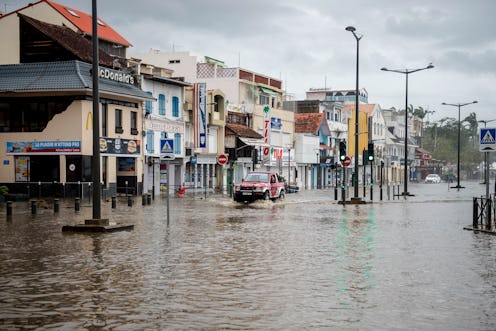News
How Hurricane Maria Could End Up As Bad As Irma

Hurricane Maria made landfall on Monday night, and it's already claimed one life in Guadeloupe and caused "mind boggling" damage to the island of Dominica. The Category 5 storm is currently barreling through the Caribbean, as Hurricanes Irma and Harvey did weeks before. However, it's impossible to say whether or not Hurricane Maria will be as bad as Irma, given the drastically different paths of the two storms.
When Maria hit Dominica on Monday evening, it was so strong that the country's prime minister had to be rescued from his home after the storm wiped out his roof.
"So, far the winds have swept away the roofs of almost every person I have spoken to or otherwise made contact with," Prime Minister Roosevelt Skerrit wrote on Facebook. "The roof to my own official residence was among the first to go and this apparently triggered an avalanche of torn away roofs in the city and the countryside." Skerrit went on to call the damage "devastating ... indeed, mind boggling." Meanwhile, at least one person died on the island of Guadeloupe as a result of Maria, and two more are missing, according to the Associated Press.
Unfortunately, Maria is poised to affect more than the relatively small islands of Dominica and Guadeloupe. The storm is scheduled to slam Puerto Rico and the Virgin Islands as well, imperiling the lives of around 3.5 million people. Maria will be the first Category 5 storm to hit Puerto Rico in over 85 years, and the National Hurricane Center says it will be "potentially catastrophic." Its winds are expected to be sustained at 160 miles per hour — but Puerto Rican Gov. Ricardo Rosselló said Tuesday that emergency workers won't be able to help residents once winds reach 50 miles per hour.
Puerto Rico and the U.S. Virgin Islands will also suffer a significant storm surge; that's when a hurricane pushes excess ocean water to the shores as it approaches a coast, causing flooding. The National Hurricane Center says that Maria's storm surge could be "life-threatening," raising water levels by as much as 9 feet in both of the U.S. territories. On top of that, Maria is expected to bring additional 12 to 18 inches of rainfall in Puerto Rico and 10 to 15 inches in the U.S. Virgin Islands by Thursday.
All of this makes it sound as if Maria will be a more catastrophic storm than Irma. After all, the worst Irma did in Puerto Rico was knock out power to a third of the island. But that doesn't capture the whole picture, because unlike Irma, Maria may very well avoid Florida entirely. Although it's too soon to say for certain, meteorologists suspect that the Sunshine State may be spared the worst of Maria's wrath, as the storm's trajectory appears to have shifted slightly to the north. If it continues along that path, Maria will most likely miss Florida, Georgia and South Carolina, all of which suffered serious damage from Irma.
"It seems at this point that most likely track for Maria would be similar to [Hurricane] Jose, staying off the coast but maybe close enough to clip the Outer Banks, maybe New England," meteorologist Rob Miller told USA TODAY. "We don't want to let our guard down. But the consensus is that the storm keeps off the coast, maybe significantly off the coast."
It's simply too soon to compare the severity of Hurricanes Maria and Irma, as Maria is still ongoing and the impact of Irma hasn't been fully assessed yet. Moreover, when all is said and done, the two storms will have impacted different countries and territories to very different degrees. Nevertheless, a Category 5 hurricane is a serious threat no matter where it hits, and if you're in any of the regions currently under hurricane warnings or watches, take all local advisories seriously, and avoid unnecessary risks if and when the storm hits.